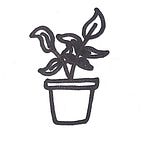Why you shouldn’t fertilize mint.
After a few months of successfully keeping my house plants alive, I decided I was ready to graduate to home-grown produce. I figured starting with herbs would be easier than jumping right into fruits and vegetables, so I went to my local home improvement store to buy a mint plant. All of what I’ve heard about mint has told me that it grows like weeds and is one of the easiest vegetables to grow. One can imagine my disappointment when only a week after buying the plant, its leaves began to wilt.
I assumed that I had simply drowned the poor thing by over-watering, so I decided to try one more time with a second mint plant. As I did the first time, I brought the plant home, placed it in a new container with fresh potting soil, and finished by adding fertilizer. To avoid killing this one, I made sure to only water it when its soil was totally dry. Despite this, my mint plant’s beautiful green leaves began to wilt after only a few days.
What could have gone wrong? I’ve heard horror stories of mint infesting a person’s entire garden because they couldn’t stop its growth, but it seemed that I couldn’t even get it to grow in the first place. I realized that the problem was not in the watering, but the fertilizer. The people with mint infestations don’t fertilize it, they simply plant their mint in the ground and forget about it until its too late. In my case, my mint plant died quickly after being fertilized. But why?
It turns out, mint needs its soil to maintain a relatively neutral pH, ranging from 6.5 to 7. Many chemical fertilizers manipulate the acidity of the soil through the chemical reactions that convert the chemical nutrients into something the plants can intake. I hadn’t previously understood what fertilizer did to encourage plant growth. I only knew it was helpful, so I went to the store and purchased a random fertilizer without putting much thought into it.
The fertilizer I purchased was the Miracle-Gro Plant Food fertilizer, which contains 15% nitrogen, 30% phosphorous, and 15% potassium (the three main nutrients needed by plants). Nitrogen and phosphorous both alter soil acidification, while potassium has no effect. Because I used a liquid fertilizer, I had to mix it in a large amount of water to create an aqueous solution.
Upon further research on Miracle-Gro fertilizer, I discovered that the nitrogen in Miracle-Gro Plant Food is found in ammonium phosphate. Because of this, this type of fertilizer is prohibited from being used in certified organic farming because an ammonium-based fertilizer actually acidifies the soil, thus lowering the pH of already acidic soil.
The key molecule of the fertilizer (it changes depending on the type of fertilizer but generally it is a type of urea), bonds with water to create ammonia. The ammonia then bonds with an H+ ion from the soil to create ammonium. The ammonium goes through nitrification to produce two H+ ions and nitrate. This ultimately removes an H+ ion from the soil to replace it with two, thus increasing the overall acidity of the soil.
Most potting soils are already pretty acidic, with a pH ranging from 5.5 to 6. As mint plants need to grow in neutral soil, increasing this acidity is very harmful to the plant. This also explains why my tomato plant took off after first being fertilized, as tomato plants prefer slightly acidic soil. Overall, it is important to research your fertilizers and to know the needs of the specific plants you are fertilizing. Personally, I’m going to be a lot more avoidant of using chemical fertilizers in the future. Simple grass clippings or compost kitchen scraps would be much safer and much more environmentally friendly.
